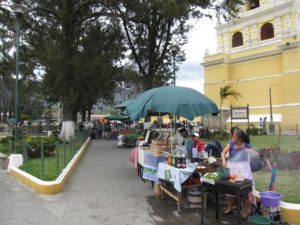Lunching and Learning
 I remember being three years old, sitting at the table in front of a cold bowl of soup I refused to eat. I rarely defied my father, but I chose that particular battle to stand and fight– and again, I lost. Like most fathers, Pop always insisted I clean my plate. Unlike most fathers, though, he was an anthropologist who took me with him on his travels and expected me to eat whatever the locals did.
I remember being three years old, sitting at the table in front of a cold bowl of soup I refused to eat. I rarely defied my father, but I chose that particular battle to stand and fight– and again, I lost. Like most fathers, Pop always insisted I clean my plate. Unlike most fathers, though, he was an anthropologist who took me with him on his travels and expected me to eat whatever the locals did.
I frequently found myself with a spoon near my face, “Pruébalo” (“Try it”), he would say and give me a grin. Working with people who frequently rationed food depending on the quality of their harvest, he wanted to make sure I realized that food was not only a labor of love and a result of hard work but also an expression of identity. How I reacted to meals could either impress like a firm handshake or offend like a slap in the face. Soon enough, I gave up fighting with Pop and started to embrace every strange meal as a learning experience.
When a friend came to dinner and politely asked if he could mix the rice with the beans, I discovered that mixing food could insult your host. When my friend’s father (born during the Great Depression) woke us up at 5 am one morning to help him clean the stables, he offered us coffee and suggested we learn to drink it black so no one would feel shame if they didn’t have milk or sugar to offer. When a Costa Rican subsistence farmer invited my father and me to eat dinner and offered up his family’s entire meal–a bowl of rice with sparse bits of vegetable and pork—to eat while they stood and watched, I realized just how much generosity food could convey.
Pop’s lesson on how respect and enthusiasm for unfamiliar foods can bring new experiences, open doors and create connections has served me well in my professional life as well. Now whenever I meet with clients or prospects across the globe, I know a sure way to get them to open up to me is to ask where to find the best local food. Not only do I get the opportunity to eat something new and usually delicious, but I’ve let them know they can trust me and be themselves around me.
My father’s lesson really hammered home when I was on a six-month stint in India in 2009 for a software company. A group of C-level executives with whom I was dining told me it was OK if I used a fork and knife, but that they would be eating with their hands. I gamely held up my hands and refused the cutlery, so they showed me how to break Indian bread (naan) with the fingers of my right hand and scoop up vegetables and sauce with it. I screwed it up a few times, and they laughed, but then the COO told a story of how an Indian official went to dinner with the Queen of England and someone made a comment about how Indians still used their hands to eat. “He held up a spoon and said, ‘This may have been used in a hundred different ways,’ and then he held up his right hand, ‘but I know exactly where this has been.’” I realized that by forgoing a fork, I had succeeded in winning over a table of friends.

